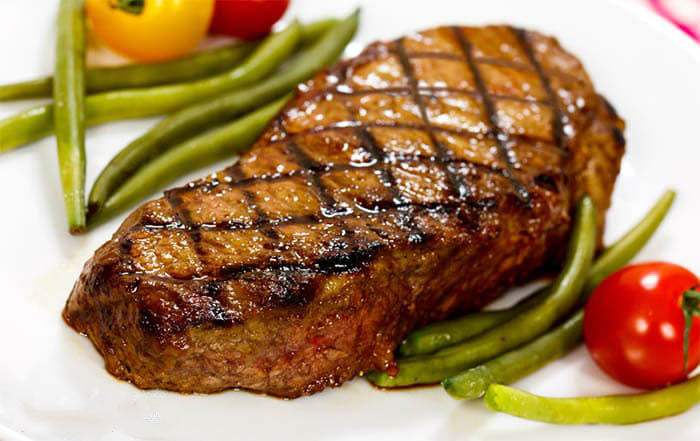
Is Saturated Fat Bad?
The history of the U.S. red meat scare
For as long as I can remember, the health experts have been telling us that we should avoid saturated fat.
Use vegetable oil instead of lard or bacon fat.
Buy skim milk instead of whole milk or heavy cream.
We see the heart healthy label on products low in saturated fat and therefore assumed them to be healthy.
We were told that red meat was bad for us because of the cholesterol and saturated fat, and that we should consume more fish and chicken instead. In some cases, we’re told we should eat only a small amount of meat, period.
I lived through the low-fat craze that started in the 1990s and is still kicking around today, but thankfully dying. Low-fat cookies always baffled me.
In 2015, the Dietary Guidelines Advisory Committee removed dietary restrictions on cholesterol. They stated that cholesterol in the diet need no longer be considered a "nutrient of concern."
This is a total reversal of the last 50 plus years of advice.
The first time the American Heart Association came out against cholesterol was in 1961. This view was later adopted by the U.S. government, and egg consumption dropped by 30%. Eggs were off the menu!
Granted, many people pretty much ignore the government's advice when it comes to food, or anything else. But still, the industry took a hit.
Red meat also took a big hit and was vilified as bad for you due to its saturated fat content. The theory goes that saturated fat intake raises your cholesterol and leads to heart disease. Therefore, if you reduce your saturated fat intake, you will reduce heart disease.
This theory was first put forth by Ancel Keys at the World Health Organization in Geneva in 1955 - it was known as the lipid, or "diet-heart" hypothesis. At first they targeted ALL dietary fat as the culprit but later narrowed their focus to saturated fat. Since saturated fat is found primarily in animal foods, they concluded that meat is bad for you.
Ancel Keys hit the cover of Time magazine and the war on saturated fat was on.
The idea that saturated fat was the enemy was picked up by the American Heart Association, and foods that were a staple in the american diet were vilified as bad almost overnight. The war raged for the last 50 years and is still raging to some degree. The genie was out of the bottle and there was no putting it back in.
Over the past half-century, I am happy to report we have made some progress in figuring out if this theory is actually founded. In 2014, the Mayo Clinic published an interesting article stating that making saturated fat a scapegoat is a questionable practice. There's no evidence to support saturated fat’s fall from grace - and there's quite a bit of evidence that saturated fat may even be beneficial (gasp!).
The doctors urged the American Heart Association, the American Diabetes Association, and the National Institute of Clinical Excellence to consider the evidence they cited when updating their future guidelines (Of course, these guidelines have yet to change their standing on saturated fat since their pledge against it in the 1950s).
So while we now know that this thinking regarding red meat and other foods with cholesterol and saturated fats was horribly over-simplified and completely wrong, an entire food industry - along with the food pyramid and everything that goes with it - had already been developed.
This incorrect theory has already shaped the way Americans, and now people around the world who have adopted these dietary guidelines, think.
And now we are stuck with the aftermath.
This inaccurate theory, and the companies that have grown from it, have already become ingrained into our modern culture.
We are now dealing with trying to feed our families with food that was developed to replace the very foods our grandparents and their parents were raised on.
Industrialized food production (a whole other subject I'll get into later!) reduced saturated fat and cholesterol and replaced it with highly processed and synthesized food, and mass-produced vegetables. There are a myriad of health issues associated with these foods and the way they're brought to existence, but they are backed by significant political and monetary power. And all because it's become a habit to follow what someone said over 50 years ago.
And the latest trend in this spiral we cannot seem to pull ourselves out of: the new product that scientists are trying to perfect is lab-made meat!
Red meat (not lab-meat) is an incredibly nutritious food in spite of its bad rap. A 3.5-ounce (100-gram) portion of raw ground beef (10% fat) contains:
- Vitamin B3 (niacin): 25% of the RDA
- Vitamin B12 (cobalamin): 37% of the RDA (this vitamin is unattainable from plant foods)
- Vitamin B6 (pyridoxine): 18% of the RDA
- Iron: 12% of the RDA (This is high-quality heme iron, which is absorbed much better than iron from plants)
- Zinc: 32% of the RDA
- Selenium: 24% of the RDA
- Plenty of other vitamins and minerals in smaller amounts
Red meat is also rich in important nutrients like creatine and carnosine. Non-meat eaters are often low in these nutrients, which may potentially affect muscle and brain function.
Grass-fed beef is even more nutritious than grain-fed, containing plenty of heart-healthy omega-3s, the fatty acid CLA, along with higher amounts of vitamins A and E.
The quality of the meat is a function of how the meat was raised and how it was fed. We don't fully understand the process, and I fear that in the rush to deal with a meat industry that has been more focused on production than quality, we will end up creating lab meat that may end up being worse for us than some of the fake fats we came up with.
In the coming months I am going to dive into the beef industry and the environmental impacts associated with it as well as the impacts of getting rid of meat and going to plant-based eating.
So, in conclusion:
"Meat is back on the menu." - Lord of the Rings

